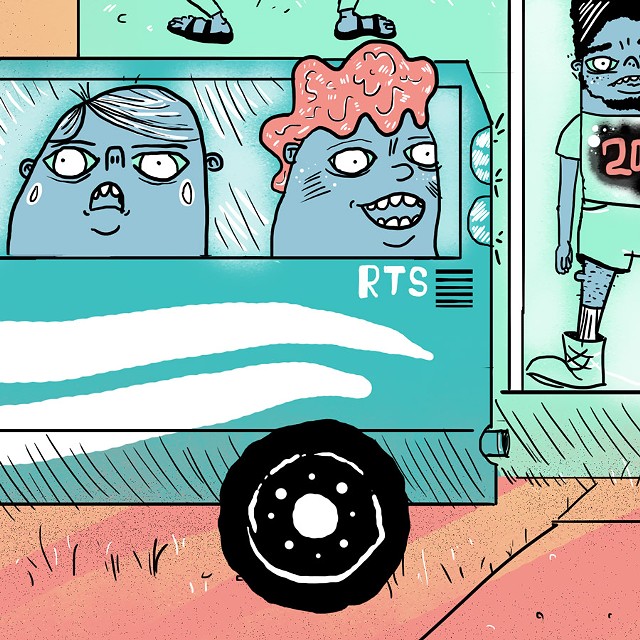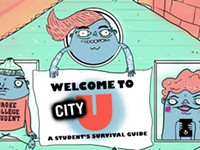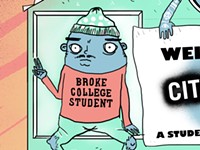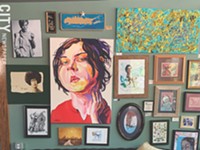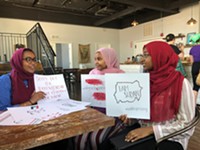[
{
"name": "500x250 Ad",
"insertPoint": "5",
"component": "15667920",
"parentWrapperClass": "",
"requiredCountToDisplay": "1"
}
]
It was Eddie Hock's first year at the University of Rochester, Hanukkah was approaching, and he needed to buy gifts. He wound up at NeedleDrop Records in the South Wedge, on the edge of downtown Rochester.
"I went in and I hung out with the owner of this record store," he says. "I had a 30-minute conversation with this guy about David Foster Wallace or something, and he gives me – free of charge – a Gameboy copy of Tetris."
And that's how Hock fell in love with downtown and the neighborhoods around it. Now he visits weekly for theater, art, live music, food – whatever suits his fancy. Sounds like your average college student, right? Except that he's not. Because most of his peers rarely go downtown at all.
Hock used to be like that. "I spent all of my time at school within the same mile and a half square, which I don't think can possibly be very healthy for your mental state," he says.
Almost all of the dozen students from six different colleges interviewed for this story had had the same experience, or witnessed it among their friends.
Wil Aiken, a junior at U of R, recalls spending almost his entire first year on the U of R campus. Neal Ganguli, a U of R senior who interned in Rochester this past summer, admits that in three months of summer, he had spent more time in the city than he had in the last three years. Rochester Institute of Technology senior Maria Lelie took matters into her own hands last year and gave one of her friends a tour of the city, because the friend was about to graduate and "had never seen anything."
This is the opposite of what city officials like Mayor Lovely Warren would like to see.
Universities have large footprints on the towns and cities they are located in, and their students are a big part of that. In many cities, students spend money there, they volunteer – and often, they stay and build their careers there. That last part isn't happening in Rochester. Instead, in 2016 CityLab put Rochester in the bottom ten when ranking places where college graduates contribute to the local economy.
"In the past, it has been more apt for students to just stay on campus," Warren says. She recognizes that in order for more college students to settle down in Rochester, they need to have fun both on and off campus, she says.
But what's getting in the way of that?
"They say that they're very busy," says Hock, but he doesn't buy it. Rather, he says, students are pressured to feel constantly busy. For U of R students, Aiken credits this feeling to the huge, impossible-to-miss, Rush Rhees library, and the "giant statues of scholars everywhere, reminding you of what you have to achieve."
Academic pressure is just the beginning. Nivializ Ortiz goes to St. John Fisher College, where she juggles her nursing coursework and planning two events a month with the Latino Students Association. Most student organizations plan that many as well, and the programming board hosts events four times a week. Throw in a dorm full of friends and a giant meal plan, and you get an environment where students can live, eat, learn, work, and play without ever leaving – or wanting to.
The weather is also to blame, says Ganguli. "If there's a foot of snow, people are barely willing to go to class," let alone trek downtown.
Winters also weed out bikes and scooters as modes of transportation, leaving students who don't have a car reliant on buses. This, as it turns out, can be a problem. Students have all sorts of explanations for why they don't use Regional Transit Service buses, Rochester's main form of public transportation.
Ganguli says he found the buses inefficient. "If I took the bus to work it would take me 30, 45 minutes, and if I ride my bike it's 20," he says. Aiken's RTS trips usually end in frustrating but comical situations: He misses his stop or ends up going in the wrong direction entirely. Or even when nothing goes wrong, he finds himself worrying that it will. Lelie, who doesn't use public transportation back home, describes trying to figure RTS out as a freshman. "It was hell the first time," she says. Which bus stop was for her bus? When should she pull the 'Stop Requested' cord?
"I went with a couple of girlfriends," she says, "and we just, like, panicked." Getting a car last year, however, has allowed Lelie to go in and out of the city as she pleased.
On top of all these factors is an even bigger one: a lack of information about the city and what it has to offer.
"There aren't a lot of people thinking 'I should go to the city,' because they don't realize Rochester is a hub," says Michelle Garrett, senior and editor of the student newspaper at Roberts Wesleyan College.
This was the common thread behind every other issue the students had brought up. They shied away from the public bus system in part because they had no information on how to use it. But even if someone had shown them how, they wouldn't have known where to go.
Robust transportation doesn't fix that problem. U of R has a bus route, called the Orange Line, which loops through southeast city neighborhoods and part of downtown seven days a week. Some U of R students interviewed for this story were surprised to hear that – and some didn't believe it.
Thanks to limited information, the city often gets a bad rap among students.
When Hock first arrived, he heard that he was going to a "good school in a bad location." Aiken says the only news he got from U of R about neighboring areas were crime updates.
"I think from afar, it seems like kind of a sucky city," Garrett says, "but I love Rochester." So did every student who frequented it.
Aiken, who has visited a number of secondhand bookstores, says he has found Rochester to be a "chatty city," with open and friendly locals. Ganguli said that after a summer in Rochester, he could see himself potentially living and working here.
Lelie calls Rochester a "hidden gem" and praises its complex history and pretty parks. "I think Rochester just has a lot to it that people aren't seeing," she says, "and I wish people were seeing it."
Some students want their university to do more to promote the city, through newsletters or residential-life programs. Hock wonders if orientation could include trips to popular downtown destinations, like the Memorial Art Gallery or the Little Theatre.
RTS has partnered with Monroe Community College to provide its students with free, universal bus passes, RTS communication manager Tom Brede says. He adds that RTS would like to build more relationships like these where universities and the transit company work together.
The transit system is also slated to receive updates that could make it more appealing to a younger, more digital generation, like mobile ticketing, smartcards, and (in specific zones) an on-demand shuttle service similar to UberPool.
Mayor Warren wants to make downtown more inviting. "What we're trying to do is build a culture of engagement downtown that we haven't had for a number of years," she says, "because you have to have somewhere to come to." She hopes that developments like the new skate park lined up and projects planned along the Genesee River, will attract more students.
But after all that, it will be up to students to get out and explore. Hock usually goes downtown alone, because going downtown isn't a normal thing students at U of R do. But, he says, it should be.
In This Guide...
Speaking of...
-

Remaining RCSD students without transportation will soon get it
Sep 24, 2021 -
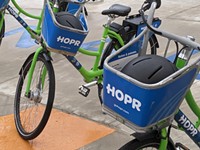
ESL grant funds HOPR bike and scooter stations
Sep 15, 2021 -
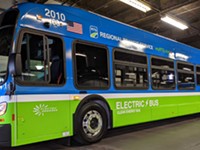
RTS introduces electric buses to its fleet
Oct 7, 2020 - More »
